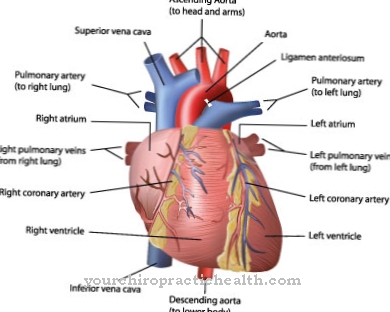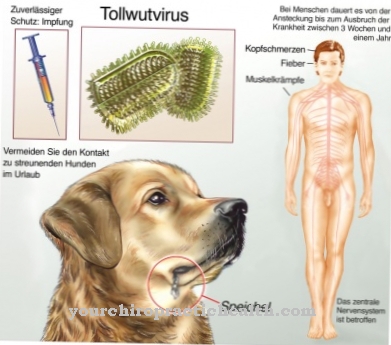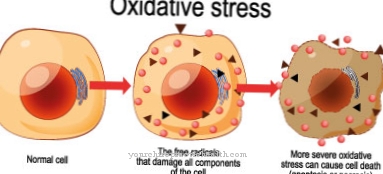As a Ectropion is an outward curvature of the eyelid, which mostly affects the lower eyelid. The affected eye usually shows reddening, frequent tears (tear drainage over the edge of the eyelid) as well as chronic connective and, later, corneal irritation. With early therapy, ectropion is reversible and, depending on the causes, does not lead to any consequential damage.
What is an ectropion?
.jpg)
© rangizzz - stock.adobe.com
Ectropion is a malposition of the eyelid in which the edge of the eyelid is turned outwards. This means that both the conjunctiva and the cornea are exposed during an ectropion and can easily dry out.
This leads to chronic irritation of the conjunctiva (conjunctivitis) with the characteristic symptoms such as reddening, burning eyes and tears (epiphora).
In the further course, corneal inflammation (keratoconjunctivitis) can develop, which is associated with a cloudy cornea, increased sensitivity of the eye to light and limited vision.
causes
Ectropion is usually an acquired eyelid malposition, which is mostly due to age-related factors (Ectropium senile) or scarring (Ectropium cicatriceum). In the case of age-related ectropion, the lower eyelid muscles are partially slack, so that there is a disproportion between the closing and opening muscles and, accordingly, the eyelid is turned outwards (ectropion).
Postoperative scars and changes in the eyelid tissue caused by skin diseases can also result in a shortening of the eyelid skin and the eyelid malposition typical of an ectropion. Partial paralysis of the facial muscles (facial paralysis) can also lead to the eyelid turning outwards (paralytic ectropion).
Swellings and tumors in the area of the lid can mechanically pull it down and cause ectropion. In rare cases, an ectropion is congenital (Ectropium congenitum), the cause of which is suspected to be a genetic disorder of the lid plate formation.
You can find your medication here
➔ Medicines for eye infectionsSymptoms, ailments & signs
Turning the eyelid outwards makes the patient's everyday life much more difficult and significantly reduces the quality of life. Usually, patients suffer from a number of different eye complaints. The main result is very dry eyes, which can also be affected by itching.
The constant rubbing only increases this itching, so that the eyes are often red and in some cases can also water. If the outward rotation of the eyelid is not treated, many patients suffer from conjunctivitis, which in the worst case can lead to complete blindness. The eyes burn and are extremely reddened, which also leads to visual disturbances.
The cornea can also become inflamed and contribute to various visual problems. Especially in young people, vision loss can lead to severe psychological complaints or depression. There is pain in the eyes themselves, which can spread to the ears or head.
It can also lead to paralysis of the nerves in the face. The life expectancy of the person affected is usually not reduced by turning the eyelid outwards. In most cases, the condition can also be treated relatively well.
Diagnosis & course
Ectropion can be easily diagnosed by turning the edge of the eyelid outwards (in most cases the lower eyelid). The conjunctiva is exposed due to the deformity and the eyelid hangs down.
As part of a slit lamp examination, the doctor can also determine the extent of possible conjunctivitis and keratoconjunctivitis. Further examinations may be necessary depending on the underlying causes. If there is a suspicion of ectropion caused by paralysis, the corresponding facial nerve should be checked for its functionality.
With early treatment of an ectropion, the malalignment of the eyelid is usually reversible (i.e. curable) and, depending on the causes, does not lead to any consequential damage. Without therapeutic measures, conjunctivitis can develop in the event of an ectropion and, in the further course, keratoconjunctivitis with detachment of the cornea and scarring. In the long term, if left untreated, ectropion can cause decreased vision and blindness.
Complications
The outward turning of the eyelid can lead to various complaints and complications. In most cases, there is an increased flow of tears, which can also occur for no particular reason. Furthermore, the eyes are reddened and various types of inflammation can occur in the eyes. This inflammation is usually also associated with a decrease in eyesight and thus leads to a reduced quality of life.
For many patients, eye discomfort can lead to panic attacks or sweating. It is not uncommon for the eyes to sting and cause eye pain. If this pain also occurs at night in the form of resting pain, it can lead to sleep disorders or irritation in the patient. In the worst case, turning the eyelid outwards without treatment can lead to complete blindness of the patient.
There are usually no complications when treating the outward rotation of the eyelid. The symptoms themselves can be treated with the help of creams and ointments. Furthermore, an operation is usually necessary to correct the symptoms surgically. If the tumor is responsible for turning the eyelid outwards, it can also be removed. Turning the eyelid outward does not reduce life expectancy.
When should you go to the doctor?
If noticeable changes to the eye are noticed, a doctor should be consulted. Ectropion always requires medical clarification. Those affected who find that the edge of the eyelid is turned outwards should speak to an ophthalmologist immediately.
This should be clarified at the latest when the eyes redden and there may also be itching and burning eyes. Chronic conjunctivitis may already have developed, which can cause permanent visual disturbances in the further course.
If left untreated, ectropion can also cause corneal inflammation. Increased sensitivity to light and severely impaired vision are typical warning signs that must be examined and treated immediately. Ectropion is especially common in the elderly and those with a damaged facial nerve.
Tumors can also damage the eyelid. If you are one of these risk groups, it is best to speak to a doctor quickly if you have the symptoms mentioned. Congenital ectropion is usually diagnosed and treated right after birth.
Doctors & therapists in your area
Treatment & Therapy
The therapeutic measures for an ectropion depend on the causes of the deformity. Eye ointments and drops are used for temporary (transient) ectropion. In most cases, however, it is a permanent, age-related deformity that is treated surgically.
The malpositioned eyelid is corrected by the surgical procedure. To do this, the eyelid suspension is shortened (lateral tarsal lung plasty) and the affected eyelid is tightened. In the case of an ectropion due to facial paralysis, the deformity is gradually reduced in most cases, depending on the regression of the paralysis, whereby ointments and drops can be used to keep the conjunctiva and cornea moist.
Furthermore, a watch glass bandage can be used to protect the cornea at night and side protective goggles during the day, which serve to reduce the gap between the eyelids. In some cases, a tarsoraphy (sewing of the lid in the outer area) is used for this purpose. If there is an ectropion due to a shortening of the eyelid skin caused by scars, the tissue tension is surgically minimized by shifting skin flaps or by using skin grafts (Z-plasty).
In the event of an ectropion caused by a tumor, this is surgically removed if possible and the malposition is then corrected using the appropriate procedure.
Outlook & forecast
Ectropion - an outward turn of the eyelid - is the opposite of the inward turn of the eyelids. Here, too, the prognosis is very good with early treatment. The longer the ectropion persists, the greater the risk of adverse health effects and sequelae. Chronic conjunctivitis, keratinization of the eyelid margin or hypertrophy are possible.
The prognosis improves when the outward curvature of the eyelid is surgically corrected quickly and promptly. The condition usually does not normalize on its own. An exception are situations in which the triggering factor for the outward turning of the eyelid does not apply. Only in this case can the outward curvature of one or both eyelids improve without surgery. This prognosis is based on the assumption that the causes of the misalignment of the eyelid will be recognized and corrected relatively quickly.
Most of the time, delaying the operation makes the ectropion worse. Those affected permanently wipe away the tears that run down. You thereby generate a so-called wiping ectropion. This can lead to progressive eye damage. In extreme cases, the cornea of the eye can be so damaged that there is a risk of blindness. Since the outwardly turned eyelid can be easily repaired surgically, there is no reason to take such risks.
Possible complications that can arise from surgical scarring are problematic.
You can find your medication here
➔ Medicines for eye infectionsprevention
To prevent ectropion, conjunctivitis and inflammation of the eyelid margin should be treated early. In addition, eye injuries, which can lead to scarring, should be avoided as much as possible. The risk of ectropion must be taken into account during cosmetic operations on the eye (with drooping eyelids or bags under the eyes). Constant wiping movements should also be avoided when there are drops of tears, as these promote ectropion.
Aftercare
If the eyelid is turned outwards, there are usually no special follow-up options available to the patient. With this disease, the person concerned must first have a full diagnosis and treatment by a doctor so that there are no further complications. After a successful treatment of the turned-out eyelid, no further aftercare is usually necessary.
If the outward curvature of the eyelid is treated by an operative or surgical procedure, it is advisable to protect the eye in any case. A bandage is usually placed around the eye.If medication or eye drops are used to relieve the eyelid from turning away, they should always be applied regularly and correctly.
In cases of doubt, a doctor should always be consulted so that there are no further complications. Complete healing of the outward curvature of the eyelid is not always possible, which is why an early diagnosis is very important. As a rule, those affected need to have regular examinations even after treatment. The life expectancy of the person affected is not negatively influenced or otherwise reduced by this disease.
You can do that yourself
In the case of an ectropion, the person affected has no options for healing the deformity. In everyday life, it is important for him to find a way to lead a good life with the disease or to achieve relief when symptoms occur.
As the eyes often dry out and the eyelids become reddened, creams and ointments can be used to support the skin. Eye drops also help. The use of makeup products should be avoided. Sufficient fluids must be supplied to the organism to keep it from drying out.
Scratching or rubbing the eyelids should be completely avoided. Anything that puts additional strain on the eyes or sight is also to be avoided. By wearing accessories or fashionable accents, the patient can distract from the misalignment of the eyelid or hide it.
For emotional strengthening, it is advisable to maintain an exchange with friends, relatives or people who are also sick. Tips and assistance can be exchanged and fears and worries can be discussed. Relaxation techniques are often used by the patient for mental stabilization. You can use yoga or meditation to reduce everyday stress in regular training sessions or simple exercise units. At the same time, new reserves are built up for the challenges of everyday life.













.jpg)

.jpg)
.jpg)











.jpg)